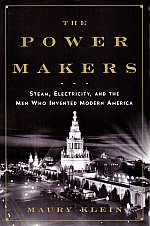Wednesday, 25 March 2009
More power to ’em
This evening, Glenn linked a Wired article by Brendan Koerner, “Power to the People: 7 Ways to Fix the Grid, Now.†It’s not a bad article, as such go, at least as a layman’s explanation of the issue.[1] But it gets off on the wrong foot with this inaccuracy:
You see, Edison’s system was Direct Current, and in those pre-transistor days, D.C. presented a problem: Practical transmission of D.C. electric power was limited to a mile or so, because of cable resistance. More than a mile, and the conductors had to be made so thick as to be impractical. Oh, you could raise the transmission voltage, but higher voltage would be more hazardous, and there was no efficient way to knock a high transmission voltage down to something more suitable for consumer use. So Edison’s central generating stations were limited to locations where the customer density was high enough to keep the transmission lines short. For others, Edison’s “Company for Isolated Lighting†would install stand-alone generating plants.[2]
Westinghouse, on the other hand, championed an Alternating Current system. A.C. could utilize high transmission voltages, even voltages greater than the generators produced, because A.C. voltages can be raised or lowered by using a simple, no-moving-parts device made up of two coils of wire wrapped around an iron core: the transformer. The advantages were obvious, especially for locations that required long transmission distances or had low customer density. When the famous Niagara Falls.power project went on line in 1895, it was equipped with Westinghouse A.C. generators. Edison, on the other hand, continued to champion D.C., and came late to the A.C. party.
So Koerner gets it exactly backward (maybe he was too busy frothing at the Edison Company’s “vertically integrated monopolyâ€). If we had continued to follow Edison’s original model, big generating plants would be found only in major urban areas. Everywhere else you’d find small neighborhood plants, or generators whirring away in the basement. The “grid,†if any, would be rudimentary. And the efficiency problem would be far greater than the 7% grid transmission losses which (a different) Wired article decries.
And the efficiency problem would be far greater than the 7% grid transmission losses which (a different) Wired article decries.
The other irony is this: For many 21st Century applications, D.C. is actually “better†power. Electronic devices, computers, radios, and the like, use D.C. exclusively. Electric heat and most types of lighting don’t care what kind of power they get; in fact A.C. lighting can produce stroboscopic effects that are annoying, and, in some circumstances, dangerous. Only certain types of motors do better with A.C. But D.C.’s advantages were swept away by A.C.’s efficiencies of large-scale generation coupled with long-distance transmission.
So in today’s home or office you can find a host of items whose first task is to convert the A.C. that comes out of the wall outlet into D.C., so they can do their jobs.
Suggested reading: Check out Maury Klein’s book The Power Makers (Bloomsbury Press, 2008) if you want to know more of the fascinating story of the electrification of America. (The image above is a link to the Barnes & Noble product page.)
-----
Comments are disabled.
Post is locked.
This evening, Glenn linked a Wired article by Brendan Koerner, “Power to the People: 7 Ways to Fix the Grid, Now.†It’s not a bad article, as such go, at least as a layman’s explanation of the issue.[1] But it gets off on the wrong foot with this inaccuracy:
Go ahead, blame Edison. He’s the guy who invented the business model that got us into this mess. Edison Electric Light, founded in 1880, was a vertically integrated monopoly that controlled everything from generation to distribution. (It even owned the bulbs in customers’ homes.) As utilities sprouted across the country, they saw no reason to deviate from Edison’s successful blueprint.Well, not exactly. Better to blame Elihu Thomson, Nikola Tesla and George Westinghouse.
You see, Edison’s system was Direct Current, and in those pre-transistor days, D.C. presented a problem: Practical transmission of D.C. electric power was limited to a mile or so, because of cable resistance. More than a mile, and the conductors had to be made so thick as to be impractical. Oh, you could raise the transmission voltage, but higher voltage would be more hazardous, and there was no efficient way to knock a high transmission voltage down to something more suitable for consumer use. So Edison’s central generating stations were limited to locations where the customer density was high enough to keep the transmission lines short. For others, Edison’s “Company for Isolated Lighting†would install stand-alone generating plants.[2]
Westinghouse, on the other hand, championed an Alternating Current system. A.C. could utilize high transmission voltages, even voltages greater than the generators produced, because A.C. voltages can be raised or lowered by using a simple, no-moving-parts device made up of two coils of wire wrapped around an iron core: the transformer. The advantages were obvious, especially for locations that required long transmission distances or had low customer density. When the famous Niagara Falls.power project went on line in 1895, it was equipped with Westinghouse A.C. generators. Edison, on the other hand, continued to champion D.C., and came late to the A.C. party.
So Koerner gets it exactly backward (maybe he was too busy frothing at the Edison Company’s “vertically integrated monopolyâ€). If we had continued to follow Edison’s original model, big generating plants would be found only in major urban areas. Everywhere else you’d find small neighborhood plants, or generators whirring away in the basement. The “grid,†if any, would be rudimentary.
 And the efficiency problem would be far greater than the 7% grid transmission losses which (a different) Wired article decries.
And the efficiency problem would be far greater than the 7% grid transmission losses which (a different) Wired article decries. The other irony is this: For many 21st Century applications, D.C. is actually “better†power. Electronic devices, computers, radios, and the like, use D.C. exclusively. Electric heat and most types of lighting don’t care what kind of power they get; in fact A.C. lighting can produce stroboscopic effects that are annoying, and, in some circumstances, dangerous. Only certain types of motors do better with A.C. But D.C.’s advantages were swept away by A.C.’s efficiencies of large-scale generation coupled with long-distance transmission.
So in today’s home or office you can find a host of items whose first task is to convert the A.C. that comes out of the wall outlet into D.C., so they can do their jobs.
Suggested reading: Check out Maury Klein’s book The Power Makers (Bloomsbury Press, 2008) if you want to know more of the fascinating story of the electrification of America. (The image above is a link to the Barnes & Noble product page.)
-----
[1] Be sure you don’t overlook the “10 Ways†in the article’s sidebar. There are some good ideas, although the mix of too much command economics with an insufficient grasp of engineering realities bothers me.
[2] One of the earliest (with its own boiler, steam engine, and dynamo) went into in the New York City home of J. Pierpont Morgan, which was too far uptown to be served by the Edison Company’s pioneering Pearl Street generating plant.
[2] One of the earliest (with its own boiler, steam engine, and dynamo) went into in the New York City home of J. Pierpont Morgan, which was too far uptown to be served by the Edison Company’s pioneering Pearl Street generating plant.
Posted by: Old Grouch in
In Passing
at
01:19:05 GMT
| Comments (1)
| Add Comment
Post contains 658 words, total size 6 kb.
73kb generated in CPU 0.0178, elapsed 0.3899 seconds.
53 queries taking 0.3826 seconds, 202 records returned.
Powered by Minx 1.1.6c-pink.
53 queries taking 0.3826 seconds, 202 records returned.
Powered by Minx 1.1.6c-pink.














